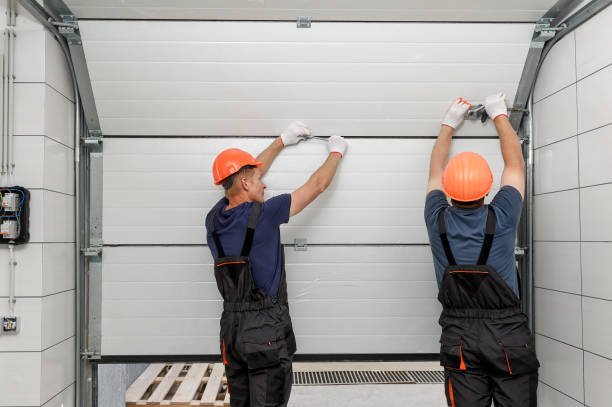
The garage door is a vital part of your home, providing security for your vehicles and belongings, and offering convenient access. Like any other hardworking component, garage doors can wear down or malfunction over time. This article will guide you through both garage door repairs and installations, helping you maintain a smooth-running and secure entryway.
Recognizing When Repairs Are Needed
Many garage door problems are easy to identify. Here are some common signs that your garage door needs attention:
- Unusual Noises: Grinding, screeching, or clanging sounds during operation indicate potential issues with the tracks, rollers, or opener mechanism.
- Uneven Movement: A jerky or unbalanced movement can point to misaligned tracks, worn rollers, or a failing spring.
- Difficulty Opening or Closing: If the door becomes increasingly difficult to operate manually or with the opener, it suggests problems with the springs, opener, or sensors.
- Visible Damage: Dents, cracks, or warping on the door itself, or loose hardware, can all compromise security and operation.
- Automatic Reversal: Modern garage doors have safety sensors that cause them to reverse if something obstructs the path. Frequent or unexplained reversals might indicate sensor misalignment or malfunction.
DIY Repairs vs. Calling a Professional
For some basic issues, like a loose screw or cleaning the tracks, a DIY approach might be possible. However, for most repairs, especially those involving springs, openers, or electrical components, it’s best to call a professional. Here’s why:
- Safety Concerns: Garage door springs are under immense tension and can cause serious injury if they break or detach improperly.
- Expertise and Tools: Professionals have the expertise to diagnose problems quickly and efficiently. They also possess specialized tools for safe and effective repairs.
- Warranty Considerations: Attempting DIY repairs on a door under warranty might void the coverage.
The Garage Door Installation Process
If your existing garage door is beyond repair or you simply want a modern upgrade, then garage door installation is the way to go. Here’s a simplified breakdown of the process:
- Choosing Your Door: Consider factors like material (steel, wood, composite), insulation level, and design aesthetics.
- Obtaining Permits (if necessary): Some localities might require permits for garage door replacements.
- Scheduling Installation: Reputable companies will conduct a site inspection to assess your needs and provide a detailed quote.
- Door Removal and Prep Work: The technicians will carefully remove your existing door and prepare the opening for the new one.
- Door Installation: The new door will be secured to the frame, and all necessary hardware will be installed.
- Opener Installation (if applicable): If you’re installing a new opener or replacing the existing one, this will be done at this stage.
- Safety Testing and Programming: The technicians will thoroughly test the door’s operation and safety features. They’ll also program your garage door opener remotes.
Finding the Right Garage Door Company
When selecting a company for repairs or installation, prioritize these factors:
- Reputation and Licensing: Look for companies with a proven track record, positive customer reviews, and proper licensing for your area.
- Experience: Choose a company with experience in handling your specific door type and opener brand.
- Insurance: Ensure the company has liability and worker’s compensation insurance for your peace of mind.
- Warranties: Inquire about warranties offered on both parts and labor.
By understanding the signs of trouble, the pros and cons of DIY repairs, and the installation process, you’ll be well-equipped to keep your garage door functioning smoothly and securely for years to come. Don’t hesitate to seek help from a qualified professional when necessary – a properly maintained garage door safeguards your property and offers lasting peace of mind.
